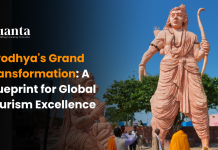What caused the Uttarakhand disaster?
A glacial lake burst, a cloud burst or an avalanche, the impact of climate change or “development” — scientists are not sure what triggered the sudden surge of water near Chamoli in Uttarakhand Sunday morning that briefly raised fears of a repeat of the 2013 disaster in the state.
As scientists prepared to travel to the site in the high mountains north of Chamoli to ascertain the cause of the incident, the scenario being most talked about was what glaciologists like to call a GLOF, or glacial lake outburst flood..
It is a reference to flooding caused downstream due to a breach in a glacial lake.
What is GLOF? (glacial lake outburst flood)
A GLOF event is where a naturally formed lake of glacial meltwater is breached, causing a catastrophic release of large volumes of water downstream.
Glaciers on mountain tops and the sides of mountains accumulate ice from snowfall. This ice melts in a process called ablation, adding water to downstream water bodies and rivers. The process is continuous and is a part of the Earth’s natural water cycle.
As a glacier retreats, i.e., reduces in size because of melting, it leaves sediments in the melted freshwater in the form of clay and sand as well as rocks, boulders, and gravel. These deposits often create natural dams called moraines that contain meltwater within.
These natural dams or glacial lakes can overflow or be punctured/breached, leading to flooding downstream.
Breaching of moraines can be triggered by avalanches, earthquakes or a natural collapse of moraines due to excessive pressure from water. Also contributing to GLOFs are anthropogenic (human-induced) activities such as deforestation and pollution, which change local climate. Pollution exacerbates the potential for disasters through the release of black soot particles, which can settle on ice, absorbing more heat and accelerating melting.
Fragmentation of glacial ice can also trigger a breach in terminal moraines or dam boundaries, either through direct impact or by displacement waves, which compromise the stability of the dam. This is suspected to have occurred in Chamoli.
GLOF events are not unusual, but their impact depends on the size of the proglacial lake that burst, and location. The breach can be caused by several reasons — in this particular case, for instance, an avalanche was reported in the region two days ago.
But while GLOF is being considered to be the most likely trigger for Sunday’s event, there are questions surrounding this possibility. “We don’t know of any big glacial lakes in this region. An avalanche is quite common, and there could have been one, but an avalanche on its own would not result in an increase in the flow of water in the river. The water has to come from a source, and as of now, we do not know what this source is,” said Professor H C Nainwal, a glaciologist at the Hemwati Nandan Bahuguna Garhwal University in Srinagar, Uttarakhand.
Plus, there were no cloudbursts or earthquakes recorded in the past few days, so what caused the glacial lake breach(if at all there was one) is a question mark.(so glof theory is a lil weak)(landslide due to breaking of glacier looks more plausible
But, was it really a GLOF? Some people say it wasn’t.
Scientists studying satellite imagery from before & after the disaster say a chunk of glacier appears to have crashed down a mountain, triggering a landslide & subsequent floods.
International geologists and glaciologists studying satellite imagery say the cause of the Chamoli flooding disaster in Uttarakhand appears to be a landslide and not a glacial outburst as widely believed.
Earlier reports stated that the flooding was caused by a glacial lake outburst flood (GLOF), which occurs when a natural lake is formed from a glacial ice melt and the lake is breached. However, available satellite images seemingly do not show the presence of a glacial lake before the flooding event.
Images from Copernicus’s Sentinel 2 satellite also showed the formation or opening of a crack in the Nanda Devi glacier that is believed to have triggered the landslide
In all likelihood, a steep, hanging portion of the Nanda Devi glacier broke off at Trishuli, in what is called a ‘rockslope detachment’. This potentially caused nearly 2,00,000 square metres of ice to drop 2 kilometres vertically, causing a landslide, impacting the valley floor and shattering instantly. This debris, rock, and ice then flowed downslope in the form of an avalanche, identified by the dust trail in the satellite imagery.
This avalanche flowed onto the glacier itself. Such intense flows of rock can cause tremendous heat generation, melting ice and causing transient, slushy lakes and/or water flows.
These large volumes of ice, spanning nearly 3.5 km, would have further melted due to the heat generated by the landslide and avalanche, leading to the huge volumes of water that flooded the rivers.
LESSONS FOR HUMANITY(author’s personal opinion, but kaafi relevant)
(so, all these points can be said, when asked, “what went wrong” or “what could be done”)
Such disasters are as much man-made as they are acts of nature.
An unusually heavy burst of rain, or the unpredictable behaviour of a glacier(likely to have happened in this case), or even an earthquake, would have far less damaging effects if the natural forests had been kept intact, if the roads had been built with more care, if no dams had been designed or built, if the siting of homes and hotels had kept in mind the distinctive ecology of the Himalaya.
Because carelessly-constructed roads and dams lead to large amounts of debris being dumped, hill rivers become more violent and turbulent.
Because permissions to build hotels and buildings are given regardless of local needs and constraints, hillsides become weaker and more likely to collapse when threatened by storms and floods. (this is impppppppp)
The loss of life and livelihood that results is therefore as much a consequence of such faulty policy-making, and of corruption and human greed, as it is of the “wrath of nature” per se.
For all these reasons, there should be an absolute moratorium on dam projects in the Himalaya
Even outside the Himalaya, we need to follow a wiser and more environmentally-responsible pattern of development. India’s high population densities, and the fragility of tropical ecologies, mean that we cannot – and must not – mechanically imitate the energy-intensive, capital-intensive model of industrialization adopted in the West. We must seek to achieve growth and prosperity with less resource-extractive and more sustainable methods.
A crucial lesson of this latest Himalayan tragedy is that for us to adopt a more sustainable path, elected politicians must be more willing to take advice from scientific experts, and be less amenable to bribery by deal-makers. At present, the decision on where and how to build a port, or highway, or dam, or airport, is made by three sets of people – ministers, bureaucrats, and contractors. Those who know hydrology, or traffic management, or energy planning, or mountain ecology, are rarely (if ever) consulted, even if they might be close at hand. That the neta-babu-thekedar complex breeds corruption is well-known; that it generates inefficiency, incompetence, and environmental disasters is less widely recognized. (IMPPPP SHIT)
(UNIQUE POINT THIS)
The fuller and deeper decentralization of political decision-making is likely to aid more sustainable (and equitable) economic policies. The advantages of local control over natural resources are abundantly demonstrated by the success of Community Forest Management in the Gadchiroli district of Maharashtra. Here, when villagers were given control over mixed forests earlier managed by the state bureaucracy, these forests grew much thicker, while generating a steady stream of income and employment as well.
The Gadchiroli model should be emulated in other forested districts of central India, where it might likewise regenerate nature, renew the economy, and ameliorate tribal discontent. And its lessons must be heeded more broadly. Wider consultation, a greater devolution of financial and decision-making powers to panchayats and municipalities, is likely to lead to wiser and better policies in other sectors too.
To structure your CAT online preparation in an efficient way consider joining iQuanta which is a top online cat coaching institute and being a part of the iQuanta CAT 22 Course.
You can also check out and be a part of their Facebook group for peer learning, doubt solving and free material.
For 24*7 doubts-solving, FREE guidance and counselling and peer to peer learning, join the CAT preparation Fb group below:







